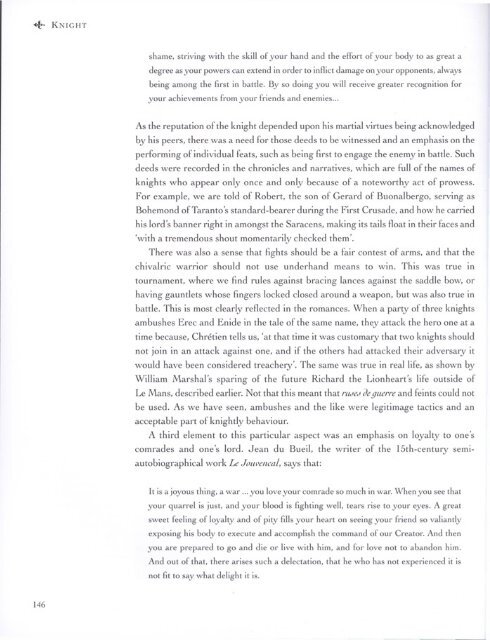Osprey - General Military - Knight - The Warrior and ... - Brego-weard
Osprey - General Military - Knight - The Warrior and ... - Brego-weard
Osprey - General Military - Knight - The Warrior and ... - Brego-weard
Create successful ePaper yourself
Turn your PDF publications into a flip-book with our unique Google optimized e-Paper software.
shame, striving with the skill of your h<strong>and</strong> <strong>and</strong> the effort of your body to as great a<br />
degree as your powers can extend in order to inflict damage on your opponents, always<br />
being among the first in battle. By so doing you will receive greater recognition for<br />
your achievements from your friends <strong>and</strong> enemies...<br />
As the reputation of the knight depended upon his martial virtues being acknowledged<br />
by his peers, there was a need for those deeds to be witnessed <strong>and</strong> an emphasis on the<br />
performing of individual teats, such as being first to engage the enemy in battle. Such<br />
deeds were recorded in the chronicles <strong>and</strong> narratives, which are full of the names of<br />
knights who appear only once <strong>and</strong> only because of a noteworthy act of prowess.<br />
For example, we are told ot Robert, the son of Gerard of Buonalbergo, serving as<br />
Bohemond of Taranto's st<strong>and</strong>ard-bearer during the First Crusade, <strong>and</strong> how he carried<br />
his lord's banner right in amongst the Saracens, making its tails float in their faces <strong>and</strong><br />
'with a tremendous shout momentarily checked them'.<br />
<strong>The</strong>re was also a sense that fights should be a fair contest of arms, <strong>and</strong> that the<br />
chivalric warrior should not use underh<strong>and</strong> means to win. This was true in<br />
tournament, where we find rules against bracing lances against the saddle bow, or<br />
having gauntlets whose fingers locked closed around a weapon, but was also true in<br />
battle. This is most clearly reflected in the romances. When a party of three knights<br />
ambushes Erec <strong>and</strong> Enide in the tale of the same name, they attack the hero one at a<br />
time because, Chretien tells us, 'at that time it was customary that two knights should<br />
not join in an attack against one, <strong>and</strong> if the others had attacked their adversary it<br />
would have been considered treachery'. <strong>The</strong> same was true in real life, as shown by<br />
William Marshal's sparing of the future Richard the Lionheart's life outside ot<br />
Le Mans, described earlier. Not that this meant that rudej de guerre <strong>and</strong> feints could not<br />
be used. As we have seen, ambushes <strong>and</strong> the like were legitimage tactics <strong>and</strong> an<br />
acceptable part of knightly behaviour.<br />
A third element to this particular aspect was an emphasis on loyalty to one's<br />
comrades <strong>and</strong> one's lord. Jean du Bueil, the writer of the 15th-century semi-<br />
autobiographical work Le Jouvencal, says that:<br />
It is a joyous thing, a war ... you love your comrade so much in war. When you see that<br />
your quarrel is just, <strong>and</strong> your blood is fighting well, tears rise to your eyes. A great<br />
sweet feeling of loyalty <strong>and</strong> of pity fills your heart on seeing your friend so valiantly<br />
exposing his body to execute <strong>and</strong> accomplish the comm<strong>and</strong> of our Creator. And then<br />
you are prepared to go <strong>and</strong> die or live with him, <strong>and</strong> for love not to ab<strong>and</strong>on him.<br />
And out of that, there arises such a delectation, that he who has not experienced it is<br />
not fit to say what delight it is.







